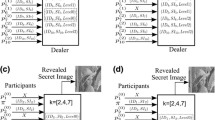Abstract
In most secret image sharing schemes, the secrecy level of each pixel is the same. However, in real applications, different pixels may require different secrecy levels. For example, in a patient’s medical image, the region with the patient’s name must be highly protected. To solve this problem, Wang and Lin proposed a scheme that allows a dealer to divide an image into multiple regions, each of which is associated with a certain level of secrecy. In their scheme, an extra pixel-security-level map (PSLM) is required to record the secrecy level of each pixel, and the shadow size of the PSLM is approximately 20 % of that of the secret image. It is unreasonable to have such a large overhead. To reduce the shadow size of the PSLM, they restricted each region to be a rectangle. Furthermore, any two participants can reconstruct the PSLM, enabling the content of regions with high secrecy levels to be compromised easily. To resolve these disadvantages, this paper proposes a new encoding scheme for PSLMs. The location of each region is protected according to its secrecy level, thus improving the security of the image. Moreover, the shape of each region is unrestricted, and the shadow size of the PSLM is reduced significantly.







Similar content being viewed by others
References
Chen SK (2005) Fault-tolerant and progressive transmission of images. Pattern Recogn 38(12):2466–2471
Chen LS-T, Lin JC (2010) Multithreshold progressive image sharing with compact shadows. J Electron Imag 19(1):013003
Huang TS (1977) Coding of two tone images. IEEE Trans Commun Com 25(11):1406–1424
Lin YY, Wang RZ (2010) Scalable secret image sharing with smaller shadow images. IEEE Sig Process Lett 17(3):316–319
Liu W, Wang A, Chang CC, Li Z, Liu L (2015) A grouped-scalable secret image sharing scheme. Multimed Tools Applic 74:7095–7109
Shamir A (1979) How to share a secret. Commun ACM 22(11):612–613
Stalling W (2002) Cryptography and network security. principles and practice, 3rd Edition. Prentice Hall, Inc., Upper Saddle River, New Jersey: Chap. 4, 104–137
Thien CC, Lin JC (2002) Secret image sharing. Comput Graph 26:765–770
Wang RZ, Lin YY (2011) Polynomial-style region incremental multisecret image sharing. Opt Eng 50(3):037004
Wang RZ, Shyu SJ (2007) Scalable secret image sharing. Signal Process Image Commun 22(4):363–373
Yang CN, Chu YY (2011) A general (k, n) scalable secret image sharing scheme with the smooth scalability. J Syst Softw 84(10):1726–1733
Yang CN, Huang SM (2010) Constructions and properties of k out of n scalable secret image sharing. Opt Commun 283(9):1750–1762
Acknowledgments
This work was supported in part by the National Science Council project under Grant NSC 103-2221-E-009-121-MY2.
Author information
Authors and Affiliations
Corresponding author
Rights and permissions
About this article
Cite this article
Chen, YR., Chen, LH. Region image sharing with various secrecy levels. Multimed Tools Appl 76, 1721–1734 (2017). https://doi.org/10.1007/s11042-015-3143-y
Received:
Revised:
Accepted:
Published:
Issue Date:
DOI: https://doi.org/10.1007/s11042-015-3143-y




